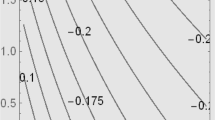Summary
In this paper we consider a two-sector economy in which individual unions are affiliated into a federation of unions. We analyze the consequences of two different types of wage setting. Firstly, individual unions set wages in their own sector without taking into account the effect of their wages on the employment level in the other sector. There may be positive as well as negative externalities. A positive (negative) externality may exist if a higher (lower) wage in one sector implies a higher level of employment in the other sector. Both cases may occur in our model. Secondly, wages in the two sectors are set by the federation of unions. We show that in this case higher (lower) wages result than in the first case if a positive (negative) externality exists.
Similar content being viewed by others
References
Abraham, F. (1987), ‘Bargaining Structures and Macroeconomic Performance in a Small Open European Economy with Imperfectly Competitive World Markets,’ University of Michigan, Discussion Paper no. 200.
Calmfors, L. and J. Driffill (1988), ‘Bargaining Structure, Corporatism and Macroeconomic Performance,’ Economic Policy, 6, pp. 14–61.
Cooper, R. (1988), ‘Will Share Contracts Increase Economic Welfare?,’ American Economic Review, 78, pp. 139–154.
Cooper, R. and A. John (1988), ‘Coordinating Coordination Failures in Keynesian Models,’ Quarterly Journal of Economics, 103, pp. 441–463.
Gylfason, T. and A. Lindbeck (1984a), ‘Competing Wage Claims, Cost Inflation, and Capacity Utilization,’ European Economic Review, 24, pp. 1–21.
Gylfason, T. and A. Lindbeck (1984b), ‘Union Rivalry and Wages: An Oligopolistic Approach,’ Economica, 51, pp. 129–139.
Hart, O. (1982), ‘A Model of Imperfect Competition with Keynesian Features,’ Quarterly Journal of Economics, 97, pp. 109–138.
Kehoe, P.J. (1987), ‘Coordination of Fiscal Policy in a World Economy,’ Journal of Monetary Economics, 19, pp. 349–376.
Keynes, J.M. (1936),The General Theory of Employment, Interest and Money, London.
Mulder, C.B. (1988), ‘Wage Moderating Effects of Corporatism. Decentralized versus centralized Wage Setting in a Union, Firm, Government Context,’ University of Tilburg, Discussion Paper, FEW no. 316.
Mulder, C.B. (1989), ‘Efficient and Inefficient Institutional Arrangements between Governments and Trade Unions; an Explanation of High Unemployment, Corporatism and Union Bashing,’ Tilburg University, Discussion Paper, FEW no. 375.
Nickell, S.J. and M. Andrews (1983), ‘Unions, Real Wages and Employment in Britain 1951–1979,’Oxford Economic Papers, Supplement, pp. 507–530.
Oswald, A.J. (1979), ‘Wage Determination in an Open Economy with Many Trade Unions,’Oxford Economic Papers, pp. 369–385.
Oswald, A.J. (1982), ‘The Economic Theory of Trade Unions: An Introductory Survey,’ Scandinavian Journal of Economics, 87, pp. 160–193.
Varian, H. (1984),Microeconomic Analysis, New York.
Author information
Authors and Affiliations
Rights and permissions
About this article
Cite this article
Jacobs, J., Janssen, M. Coordinating unions, wages and employment. De Economist 138, 321–339 (1990). https://doi.org/10.1007/BF01857779
Issue Date:
DOI: https://doi.org/10.1007/BF01857779




